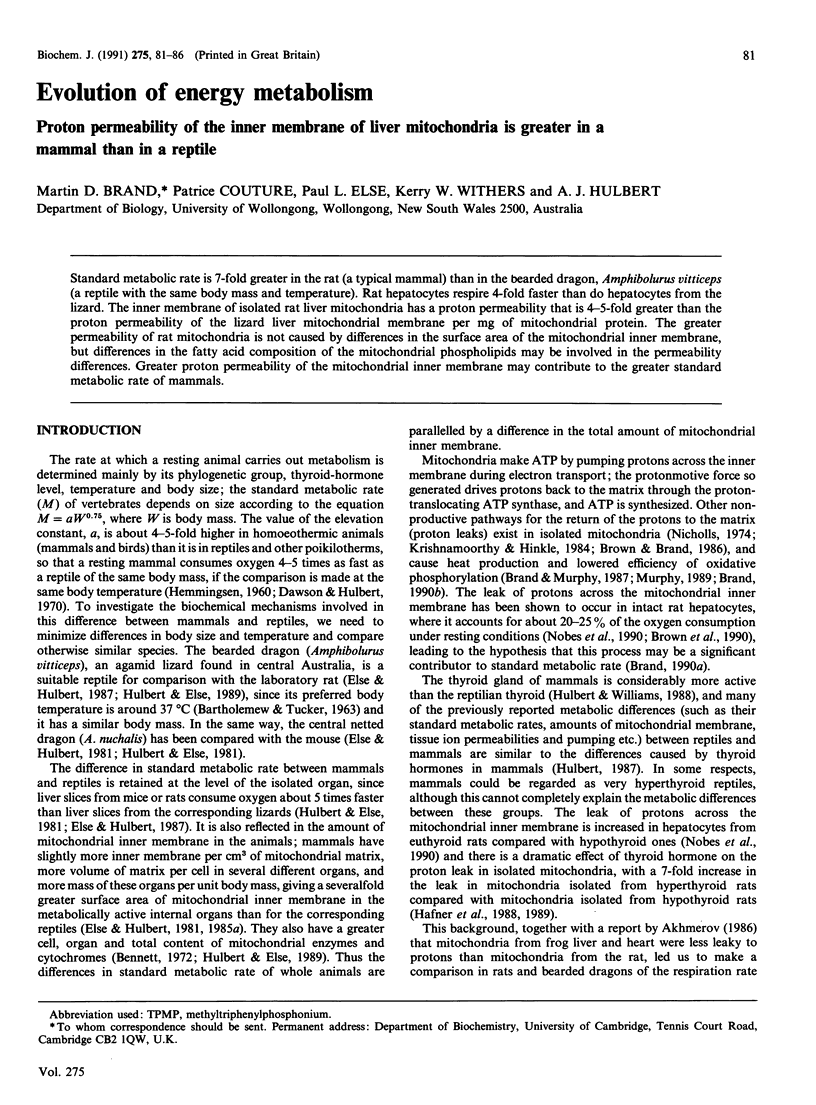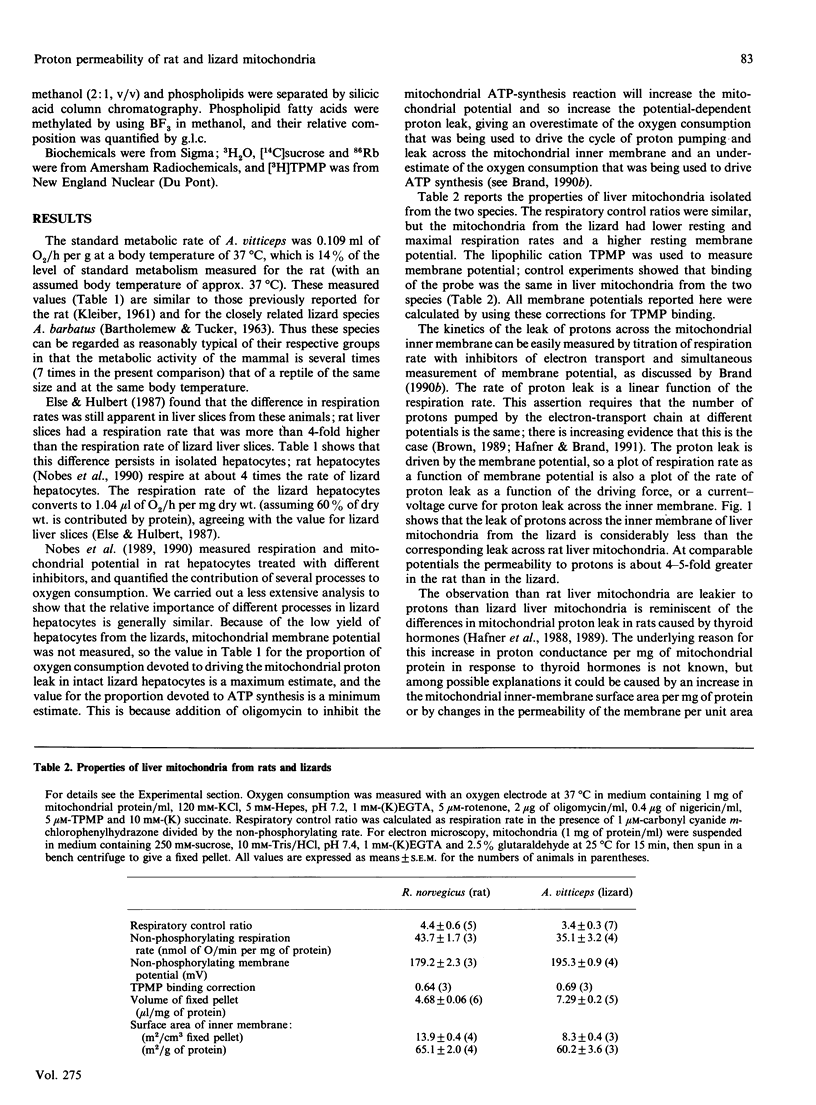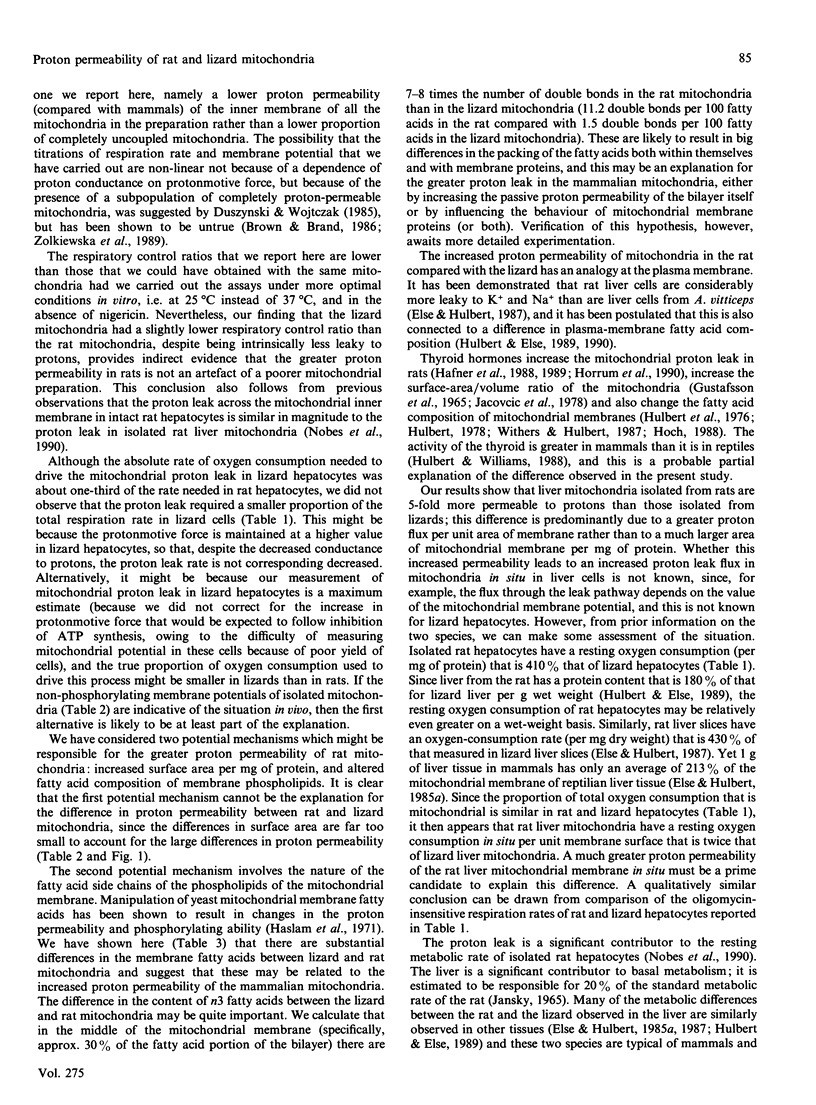Abstract
Standard metabolic rate is 7-fold greater in the rat (a typical mammal) than in the bearded dragon, Amphibolurus vitticeps (a reptile with the same body mass and temperature). Rat hepatocytes respire 4-fold faster than do hepatocytes from the lizard. The inner membrane of isolated rat liver mitochondrial has a proton permeability that is 4-5-fold greater than the proton permeability of the lizard liver mitochondrial membrane per mg of mitochondrial protein. The greater permeability of rat mitochondria is not caused by differences in the surface area of the mitochondrial inner membrane, but differences in the fatty acid composition of the mitochondrial phospholipids may be involved in the permeability differences. Greater proton permeability of the mitochondrial inner membrane may contribute to the greater standard metabolic rate of mammals.
Full text
PDF





Selected References
These references are in PubMed. This may not be the complete list of references from this article.
- Akhmerov R. N. Qualitative difference in mitochondria of endothermic and ectothermic animals. FEBS Lett. 1986 Mar 31;198(2):251–255. doi: 10.1016/0014-5793(86)80415-x. [DOI] [PubMed] [Google Scholar]
- Bennett A. F. A comparison of activities of metabolic enzymes in lizards and rats. Comp Biochem Physiol B. 1972 Aug 15;42(4):637–647. doi: 10.1016/0305-0491(72)90325-2. [DOI] [PubMed] [Google Scholar]
- Brand M. D., Murphy M. P. Control of electron flux through the respiratory chain in mitochondria and cells. Biol Rev Camb Philos Soc. 1987 May;62(2):141–193. doi: 10.1111/j.1469-185x.1987.tb01265.x. [DOI] [PubMed] [Google Scholar]
- Brand M. D. The contribution of the leak of protons across the mitochondrial inner membrane to standard metabolic rate. J Theor Biol. 1990 Jul 24;145(2):267–286. doi: 10.1016/s0022-5193(05)80131-6. [DOI] [PubMed] [Google Scholar]
- Brand M. D. The proton leak across the mitochondrial inner membrane. Biochim Biophys Acta. 1990 Jul 25;1018(2-3):128–133. doi: 10.1016/0005-2728(90)90232-s. [DOI] [PubMed] [Google Scholar]
- Brown G. C., Brand M. D. Changes in permeability to protons and other cations at high proton motive force in rat liver mitochondria. Biochem J. 1986 Feb 15;234(1):75–81. doi: 10.1042/bj2340075. [DOI] [PMC free article] [PubMed] [Google Scholar]
- Brown G. C., Brand M. D. Proton/electron stoichiometry of mitochondrial complex I estimated from the equilibrium thermodynamic force ratio. Biochem J. 1988 Jun 1;252(2):473–479. doi: 10.1042/bj2520473. [DOI] [PMC free article] [PubMed] [Google Scholar]
- Brown G. C., Brand M. D. Thermodynamic control of electron flux through mitochondrial cytochrome bc1 complex. Biochem J. 1985 Jan 15;225(2):399–405. doi: 10.1042/bj2250399. [DOI] [PMC free article] [PubMed] [Google Scholar]
- Brown G. C., Lakin-Thomas P. L., Brand M. D. Control of respiration and oxidative phosphorylation in isolated rat liver cells. Eur J Biochem. 1990 Sep 11;192(2):355–362. doi: 10.1111/j.1432-1033.1990.tb19234.x. [DOI] [PubMed] [Google Scholar]
- Brown G. C. The relative proton stoichiometries of the mitochondrial proton pumps are independent of the proton motive force. J Biol Chem. 1989 Sep 5;264(25):14704–14709. [PubMed] [Google Scholar]
- Cassuto Y. Oxidative activities of liver mitochondria from mammals, birds, reptiles and amphibia as a function of temperature. Comp Biochem Physiol B. 1971 Aug 15;39(4):919–923. doi: 10.1016/0305-0491(71)90115-5. [DOI] [PubMed] [Google Scholar]
- Conley K. E., Christian K. A., Hoppeler H., Weibel E. R. Capillary and mitochondrial unit in muscles of a large lizard. Am J Physiol. 1989 Apr;256(4 Pt 2):R982–R988. doi: 10.1152/ajpregu.1989.256.4.R982. [DOI] [PubMed] [Google Scholar]
- Dawson T. J., Hulbert A. J. Standard metabolism, body temperature, and surface areas of Australian marsupials. Am J Physiol. 1970 Apr;218(4):1233–1238. doi: 10.1152/ajplegacy.1970.218.4.1233. [DOI] [PubMed] [Google Scholar]
- Duszyński J., Wojtczak L. The apparent non-linearity of the relationship between the rate of respiration and the protonmotive force of mitochondria can be explained by heterogeneity of mitochondrial preparations. FEBS Lett. 1985 Mar 25;182(2):243–248. doi: 10.1016/0014-5793(85)80307-0. [DOI] [PubMed] [Google Scholar]
- Else P. L., Hulbert A. J. An allometric comparison of the mitochondria of mammalian and reptilian tissues: the implications for the evolution of endothermy. J Comp Physiol B. 1985;156(1):3–11. doi: 10.1007/BF00692920. [DOI] [PubMed] [Google Scholar]
- Else P. L., Hulbert A. J. Mammals: an allometric study of metabolism at tissue and mitochondrial level. Am J Physiol. 1985 Apr;248(4 Pt 2):R415–R421. doi: 10.1152/ajpregu.1985.248.4.R415. [DOI] [PubMed] [Google Scholar]
- Gustafsson R., Tata J. R., Lindberg O., Ernster L. The relationship between the structure and activity of rat skeletal muscle mitochondria after thyroidectomy and thyroid hormone treatment. J Cell Biol. 1965 Aug;26(2):555–578. doi: 10.1083/jcb.26.2.555. [DOI] [PMC free article] [PubMed] [Google Scholar]
- Hafner R. P., Brand M. D. Effect of protonmotive force on the relative proton stoichiometries of the mitochondrial proton pumps. Biochem J. 1991 Apr 1;275(Pt 1):75–80. doi: 10.1042/bj2750075. [DOI] [PMC free article] [PubMed] [Google Scholar]
- Hafner R. P., Leake M. J., Brand M. D. Hypothyroidism in rats decreases mitochondrial inner membrane cation permeability. FEBS Lett. 1989 May 8;248(1-2):175–178. doi: 10.1016/0014-5793(89)80455-7. [DOI] [PubMed] [Google Scholar]
- Hafner R. P., Nobes C. D., McGown A. D., Brand M. D. Altered relationship between protonmotive force and respiration rate in non-phosphorylating liver mitochondria isolated from rats of different thyroid hormone status. Eur J Biochem. 1988 Dec 15;178(2):511–518. doi: 10.1111/j.1432-1033.1988.tb14477.x. [DOI] [PubMed] [Google Scholar]
- Haslam J. M., Proudlock J. W., Linnane A. W. Biogenesis of mitochondria. 20. The effects of altered membrane lipid composition on mitochondrial oxidative phosphorylation in Saccharomyces cerevisiae. J Bioenerg. 1971 Dec;2(5):351–370. doi: 10.1007/BF01963830. [DOI] [PubMed] [Google Scholar]
- Hoch F. L. Lipids and thyroid hormones. Prog Lipid Res. 1988;27(3):199–270. doi: 10.1016/0163-7827(88)90013-6. [DOI] [PubMed] [Google Scholar]
- Horrum M. A., Tobin R. B., Ecklund R. E. Thyroid hormone effects on the proton permeability of rat liver mitochondria. Mol Cell Endocrinol. 1990 Jan 22;68(2-3):137–141. doi: 10.1016/0303-7207(90)90186-c. [DOI] [PubMed] [Google Scholar]
- Hulbert A. J., Augee M. L., Raison J. K. The influence of thyroid hormones on the structure and function of mitochondrial membranes. Biochim Biophys Acta. 1976 Dec 2;455(2):597–601. doi: 10.1016/0005-2736(76)90328-x. [DOI] [PubMed] [Google Scholar]
- Hulbert A. J., Else P. L. Comparison of the "mammal machine" and the "reptile machine": energy use and thyroid activity. Am J Physiol. 1981 Nov;241(5):R350–R356. doi: 10.1152/ajpregu.1981.241.5.R350. [DOI] [PubMed] [Google Scholar]
- Hulbert A. J., Else P. L. Evolution of mammalian endothermic metabolism: mitochondrial activity and cell composition. Am J Physiol. 1989 Jan;256(1 Pt 2):R63–R69. doi: 10.1152/ajpregu.1989.256.1.R63. [DOI] [PubMed] [Google Scholar]
- Hulbert A. J. The thyroid hormones: a thesis concerning their action. J Theor Biol. 1978 Jul 6;73(1):81–100. doi: 10.1016/0022-5193(78)90181-9. [DOI] [PubMed] [Google Scholar]
- Hulbert A. J., Williams C. A. Thyroid function in a lizard, a tortoise and a crocodile, compared with mammals. Comp Biochem Physiol A Comp Physiol. 1988;90(1):41–48. doi: 10.1016/0300-9629(88)91002-x. [DOI] [PubMed] [Google Scholar]
- Jakovcic S., Swift H. H., Gross N. J., Rabinowitz M. Biochemical and stereological analysis of rat liver mitochondria in different thyroid states. J Cell Biol. 1978 Jun;77(3):887–901. doi: 10.1083/jcb.77.3.887. [DOI] [PMC free article] [PubMed] [Google Scholar]
- Krishnamoorthy G., Hinkle P. C. Non-ohmic proton conductance of mitochondria and liposomes. Biochemistry. 1984 Apr 10;23(8):1640–1645. doi: 10.1021/bi00303a009. [DOI] [PubMed] [Google Scholar]
- Murphy M. P. Slip and leak in mitochondrial oxidative phosphorylation. Biochim Biophys Acta. 1989 Nov 23;977(2):123–141. doi: 10.1016/s0005-2728(89)80063-5. [DOI] [PubMed] [Google Scholar]
- Nicholls D. G. The influence of respiration and ATP hydrolysis on the proton-electrochemical gradient across the inner membrane of rat-liver mitochondria as determined by ion distribution. Eur J Biochem. 1974 Dec 16;50(1):305–315. doi: 10.1111/j.1432-1033.1974.tb03899.x. [DOI] [PubMed] [Google Scholar]
- Nobes C. D., Brown G. C., Olive P. N., Brand M. D. Non-ohmic proton conductance of the mitochondrial inner membrane in hepatocytes. J Biol Chem. 1990 Aug 5;265(22):12903–12909. [PubMed] [Google Scholar]
- Nobes C. D., Lakin-Thomas P. L., Brand M. D. The contribution of ATP turnover by the Na+/K+-ATPase to the rate of respiration of hepatocytes. Effects of thyroid status and fatty acids. Biochim Biophys Acta. 1989 Sep 28;976(2-3):241–245. doi: 10.1016/s0005-2728(89)80236-1. [DOI] [PubMed] [Google Scholar]
- Schwerzmann K., Cruz-Orive L. M., Eggman R., Sänger A., Weibel E. R. Molecular architecture of the inner membrane of mitochondria from rat liver: a combined biochemical and stereological study. J Cell Biol. 1986 Jan;102(1):97–103. doi: 10.1083/jcb.102.1.97. [DOI] [PMC free article] [PubMed] [Google Scholar]
- Zókiewska A., Zabłocka B., Duszyński J., Wojtczak L. Resting state respiration of mitochondria: reappraisal of the role of passive ion fluxes. Arch Biochem Biophys. 1989 Dec;275(2):580–590. doi: 10.1016/0003-9861(89)90404-9. [DOI] [PubMed] [Google Scholar]


